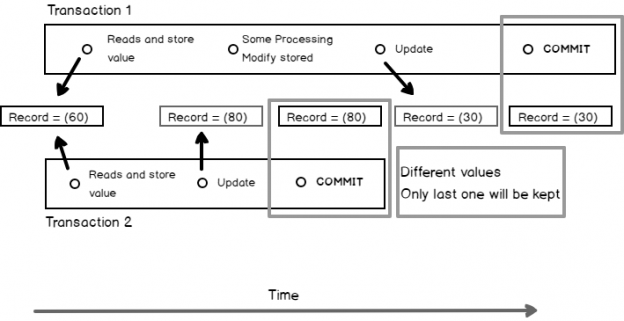Introduction
Intended audience
This document is intended for application developers and database administrators who are willing to get an overview of comm concurrency problems to which transaction isolation levels respond in the particular case of Microsoft SQL Server.
Typographical Conventions
| Convention | Meaning | ||
| Used for blocks of code, commands and script examples. Text should be interpreted exactly as presented. | ||
| Consolas Font | Used for inline code, commands or examples. Text should be interpreted exactly as presented. | ||
| <italic font in brackets> | Italic texts set in angle brackets denote a variable requiring substitution for a real value. | ||
| Italic font | Used to denote the title of a book, article, or other publication. | ||
| Note | Additional information or caveats. | ||
| About screen capture and images |
|
Context
In any relational database system, there is the concept of transaction. A transaction is a set of logical operations that have to be performed in a user session as a single piece of work. Let’s review the properties of a transaction.
Hence, a transaction must be atomic i.e. there is no halfway for it to complete: either all the logical operations occur or none of them occur.
A transaction has to be consistent i.e. any data written using database system must be valid according to defined rules like primary key uniqueness or foreign key constraints.
Once the consistency is ensured, a transaction must be permanently stored to disk. It guarantees the durability required for a transaction.
Last but not least, as multiple transactions could be running concurrently in a database system, we can find transactions that read from or writes to the same data object (row, table, index…). It introduces a set of problems to which different « transaction isolation (level) » tend to respond. A transaction isolation (level) defines how and when the database system will present changes made by any transaction to other user sessions.
In order to select the appropriate transaction isolation level, having a good understanding on common concurrency problems that can occur is mandatory.
This article is the first one of a series about transaction isolation level. It is divided into two parts. The first one will explain the concurrency problems with a theoretical example while the second will be more practical and we will try to experience these problems on a SQL Server instance.
Concurrency problems
Before diving into transaction levels details, it’s important to get used to typical concurrency problems and how we call them.
Lost update and dirty write
This phenomenon happens when two transactions access the same record and both updates this record. The following figure summarizes what could happen in a simple example.
In this example, we have 2 concurrent transactions that access a record with a (60) modifiable value. This record is identified either by its rowId or by a primary key column that won’t be presented here for simplicity.
The first transaction reads this record, does some processing then updates this record and finally commits its work. The second transaction reads the record then updates it immediately and commits. Both transactions do not update this record to the same value. This leads to a loss for the update statement performed by second transaction.
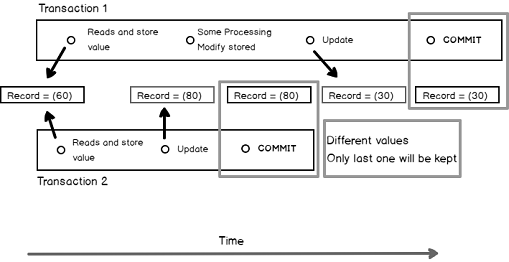
As Transaction 1 overwrites a value that Transaction 2 already modified. We could have said that Transaction 1 did a « dirty write » if Transaction 2 didn’t commit its work.
A dirty read happens when a transaction accesses a data that has been modified by another transaction but this change has not been committed or rolled back yet. Following figure shows a case of dirty read. In this example, record has two columns with a starting value of (60,40). In this context, let’s say we have an applicative constraint that says that the sum of those values must always be 100.
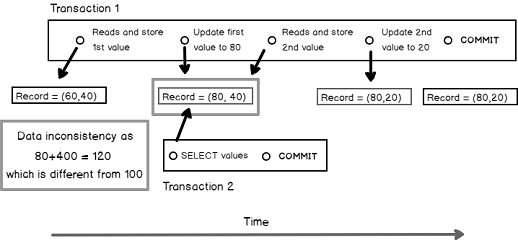
Non-repeatable read or fuzzy read
The situation of non-repeatable read is almost the same as dirty read except that both values are modified. As in previous sub-sections, we will review a graphical representation of a non-repeatable read situation. To do so, we will keep two concurrent transactions accessing two columns of the same record. One of them reads and modifies each value, one at a time, then commits while the other reads the first value, does some processing, reads the second value then commits. Keeping our constraint from previous example (the sum of both values equals 100), the presented situation leads the second transaction to manipulate inconsistent data and maybe to present it to an end-user.
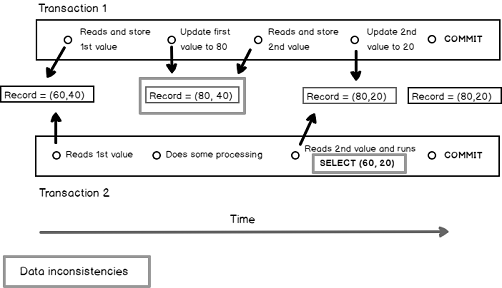
Phantom reads
Phantom reads are a variation of non-repeatable reads in the context of row sets. Here is an example that illustrates this:
Let’s say we have a transaction Transaction 1 that performs twice a SELECT query against a table T, once at its beginning and once just before its end. Let’s assume another transaction Transaction 2 starts after the first one, inserts a new row to the table T and commits before the second time Transaction 1 will run its SELECT query. The result sets that will be returned by the two occurrences of the SELECT query will differ.
Here is a diagram that summarizes the situation:
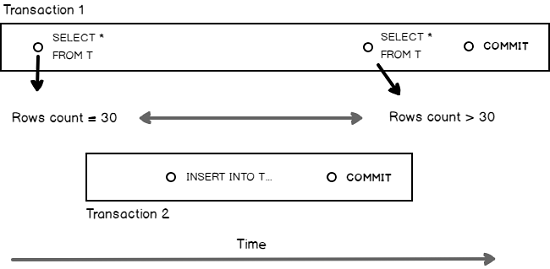
Locking reads
This is not really a concurrency problem, but more likely a “design pattern”. In short, the principle is to read a value from a given record and update this record based on the returned value inside the same transaction, with the insurance that no other session will modify the value that has just been read.
It’s the concept of SELECT FOR UPDATE in Oracle or SELECT … FROM <table> WITH (UPDLOCK) in SQL Server.
This will only work in SERIALIZABLE isolation level. We won’t discuss it anymore in this article.
Experimentation on SQL Server
The experimentation scripts presented here are all designed using the AdventureWorks2012 database.
If no precision is made about a transaction isolation level in the experimentation detailed explanation, the results presented are those returned using SQL Server’s default transaction isolation level, which is READ COMMITTED.
Lost update
Following queries depict the following scenario.
We are in a bank system. Your bank account has an initial balance of 1500 (currency does not matter). You will find below the T-SQL statement to set up the test.
|
1 2 3 4 5 6 7 8 9 10 |
CREATE TABLE BankAccounts( AccountId INT IDENTITY(1,1), BalanceAmount INT ); insert into BankAccounts ( BalanceAmount ) SELECT 1500 ; |
Your employer attempts to pay your (tiny) salary, let’s say 1600. This will consist of your first session for which you will find T-SQL statement corresponding to the action that has to be done inside the bank system.
|
1 2 3 4 5 6 7 8 9 10 11 12 13 14 15 16 17 18 19 20 21 22 23 24 25 26 27 28 29 30 31 32 |
-- Session 1: Employer DECLARE @CustomerBalance INT ; DECLARE @BalanceDifference INT ; SET @BalanceDifference = 1600 ; BEGIN TRANSACTION ; -- Getting back current balance value SELECT @CustomerBalance = BalanceAmount FROM BankAccounts WHERE AccountId = 1 ; PRINT 'Read Balance value: ' + CONVERT(VARCHAR(32),@CustomerBalance); -- adding salary amount SET @CustomerBalance = @CustomerBalance + @BalanceDifference ; -- Slowing down transaction to let tester the time -- to run query for other session PRINT 'New Balance value: ' + CONVERT(VARCHAR(32),@CustomerBalance); WAITFOR DELAY '00:00:10.000'; -- updating in table UPDATE BankAccounts SET BalanceAmount = @CustomerBalance WHERE AccountId = 1 ; -- display results for user SELECT BalanceAmount as BalanceAmountSession1 FROM BankAccounts WHERE AccountId = 1 ; COMMIT ; |
At the same time, as you’ve returned an article to your favorite web reseller, he’s also trying to add 40 to your bank account. Following code will be run:
|
1 2 3 4 5 6 7 8 9 10 11 12 13 14 15 16 17 18 19 20 21 22 23 24 25 26 27 28 29 30 |
-- Session 2: Web reseller DECLARE @CustomerBalance INT ; DECLARE @BalanceDifference INT ; SET @BalanceDifference = 40 ; BEGIN TRANSACTION ; -- Getting back current balance value SELECT @CustomerBalance = BalanceAmount FROM BankAccounts WHERE AccountId = 1 ; PRINT 'Read Balance value: ' + CONVERT(VARCHAR(32),@CustomerBalance); -- adding salary amount SET @CustomerBalance = @CustomerBalance + @BalanceDifference ; PRINT 'New Balance value: ' + CONVERT(VARCHAR(32),@CustomerBalance); -- updating in table UPDATE BankAccounts SET BalanceAmount = @CustomerBalance WHERE AccountId = 1 ; -- display results for user SELECT BalanceAmount as BalanceAmountSession2 FROM BankAccounts WHERE AccountId = 1 ; COMMIT ; |
Here are the results we will get from final SELECT in each query:




Unfortunately, we lost the money from web reseller…
Now, let’s clean up our test.
|
1 |
DROP TABLE BankAccounts ; |
Dirty read
To illustrate dirty reads, we will update data in Person.Person table: we will update all records so that all rows where FirstName column value is “Aaron” will bear the same value for it’s their corresponding LastName column. This value will be “Hotchner” but won’t persist: we will rollback the transaction.
Here is the script for the first session:
|
1 2 3 4 5 6 7 8 9 10 11 12 13 14 15 16 17 18 19 20 21 22 23 24 25 |
SELECT COUNT(DISTINCT LastName) DistinctLastNameBeforeBeginTran FROM Person.Person WHERE FirstName = 'Aaron'; BEGIN TRANSACTION; UPDATE Person.Person SET LastName = 'Hotchner' WHERE FirstName = 'Aaron' ; SELECT COUNT(DISTINCT LastName) DistinctLastNameInTransaction FROM Person.Person WHERE FirstName = 'Aaron'; WAITFOR DELAY '00:00:10.000'; ROLLBACK TRANSACTION; SELECT COUNT(DISTINCT LastName) DistinctLastNameAfterRollback FROM Person.Person WHERE FirstName = 'Aaron'; |
While the first session is in running its WAITFOR DELAY instruction, we can run following query in a second session:
|
1 2 3 4 |
SELECT COUNT(DISTINCT LastName) SecondSessionResults FROM Person.Person WHERE FirstName = 'Aaron'; |
With SQL Server’s default isolation level, the second session will be waiting for the first session to complete :

So, we can say that, by default, SQL Server protects you from dirty reads. Let’s just change session isolation level to READ UNCOMMITTED and check that SQL Server will present « dirty » data to session 2 in that mode…
In order to change session’s transaction isolation level, run following query:
|
1 |
SET TRANSACTION ISOLATION LEVEL READ UNCOMMITTED; |
Then, run the code for second session from above again.
Here are the results for both sessions:


Non-repeatable reads
If you remind the explanation above about non-repeatable reads, this problem occurs when two consecutive reads of a given column value in a particular table row lead to two different values, meaning that values returned by a query are time-dependent even inside the same transaction.
Once again, we will use two sessions for this experiment. The first session will run a query returning five first rows from Person. Person table, wait for some time then rerun the exact same query.
Here is the code for the first session:
|
1 2 3 4 5 6 7 8 9 10 11 12 13 14 15 16 17 18 19 20 21 22 23 24 25 26 27 28 29 |
-- ensure we use SQL Server default isolation level SET TRANSACTION ISOLATION LEVEL READ COMMITTED; BEGIN TRANSACTION; -- Query 1 - first run SELECT TOP 5 FirstName, MiddleName, LastName, Suffix FROM Person.Person ORDER BY LastName ; -- let some time for session 2 WAITFOR DELAY '00:00:10.000'; -- Query 1 - second run SELECT TOP 5 FirstName, MiddleName, LastName, Suffix FROM Person.Person ORDER BY LastName ; COMMIT TRANSACTION; |
While the first session is waiting, run following code that will update all records that have FirstName column value set to “Kim” and LastName column value set to “Abercrombie”.
|
1 2 3 4 5 6 7 8 9 10 11 12 13 |
-- ensure we use SQL Server default isolation level SET TRANSACTION ISOLATION LEVEL READ COMMITTED; BEGIN TRANSACTION; UPDATE Person.Person SET Suffix = 'Clothes' WHERE LastName = 'Abercrombie' AND FirstName = 'Kim'; COMMIT TRANSACTION; |
Here are the result sets returned in the first session:

We can revert our changes with following query:
|
1 2 3 4 5 6 |
UPDATE Person.Person SET Suffix = NULL WHERE LastName = 'Abercrombie' AND FirstName = 'Kim'; |
If we are willing to prevent this behavior to happen, we could have heard about the REPEATABLE READ isolation level. Let’s try it out!
For the first session, we just need to change the first command from:
|
1 |
SET TRANSACTION ISOLATION LEVEL READ COMMITTED; |
to
|
1 |
SET TRANSACTION ISOLATION LEVEL REPEATABLE READ; |
and execute it. The code for second session can be used as is.
With this simple change, we have a lock that is held by first session. This leads the second session to wait for the first one to complete before actually modify rows.
Here is a screenshot that proves it:


And, obviously, we do not forget to revert our changes to the query shown above.
Phantom reads
For this experiment, we will create a table called dbo.Employee and let it empty:
|
1 2 3 4 5 6 7 8 9 10 11 |
IF (OBJECT_ID('dbo.Employee') IS NOT NULL) BEGIN DROP TABLE [dbo].[Employee]; END; CREATE TABLE [dbo].[Employee] ( EmpId int IDENTITY(1,1) NOT NULL, EmpName nvarchar(32) NOT NULL, CONSTRAINT pk_EmpId PRIMARY KEY CLUSTERED (EmpId) ); |
In first session, we will run a SELECT query against this tablespace in time by 10 seconds:
|
1 2 3 4 5 6 7 8 9 10 11 12 13 14 15 16 17 18 19 |
-- ensure we use SQL Server default isolation level SET TRANSACTION ISOLATION LEVEL READ COMMITTED; BEGIN TRANSACTION; -- Query 1 - first run SELECT * FROM dbo.Employee ; -- let some time for session 2 WAITFOR DELAY '00:00:10.000'; -- Query 1 - second run SELECT * FROM dbo.Employee ; COMMIT TRANSACTION; |
In second session, we will insert some rows in dbo.Employee table.
|
1 2 3 4 5 6 7 8 9 10 11 |
-- ensure we use SQL Server default isolation level SET TRANSACTION ISOLATION LEVEL READ COMMITTED; BEGIN TRANSACTION; INSERT INTO [dbo].[Employee] ([EmpName]) VALUES ('Oby'); INSERT INTO [dbo].[Employee] ([EmpName]) VALUES ('One'); INSERT INTO [dbo].[Employee] ([EmpName]) VALUES ('Ken'); INSERT INTO [dbo].[Employee] ([EmpName]) VALUES ('Tukee'); COMMIT TRANSACTION; |
And here are the results sets returned in first session:

As we can see, duet o concurrency (and transaction isolation level), it’s possible to get different results sets for the same query, from time to time even in the same transaction.
Summary
So far, we’ve seen that the concurrency of transactions implies some basic issues that transaction isolation level can eventually prevent them to happen.
In the next article, you will get more details about each transaction isolation level, included what common concurrency problem(s) they solve…
References
- A Critique of ANSI SQL Isolation Levels
- Isolation Levels in the Database Engine
- Difference between Non- repeatable read and Phantom read
- How to perform a performance test against a SQL Server instance - September 14, 2018
- Concurrency problems – theory and experimentation in SQL Server - July 24, 2018
- How to link two SQL Server instances with Kerberos - July 5, 2018

